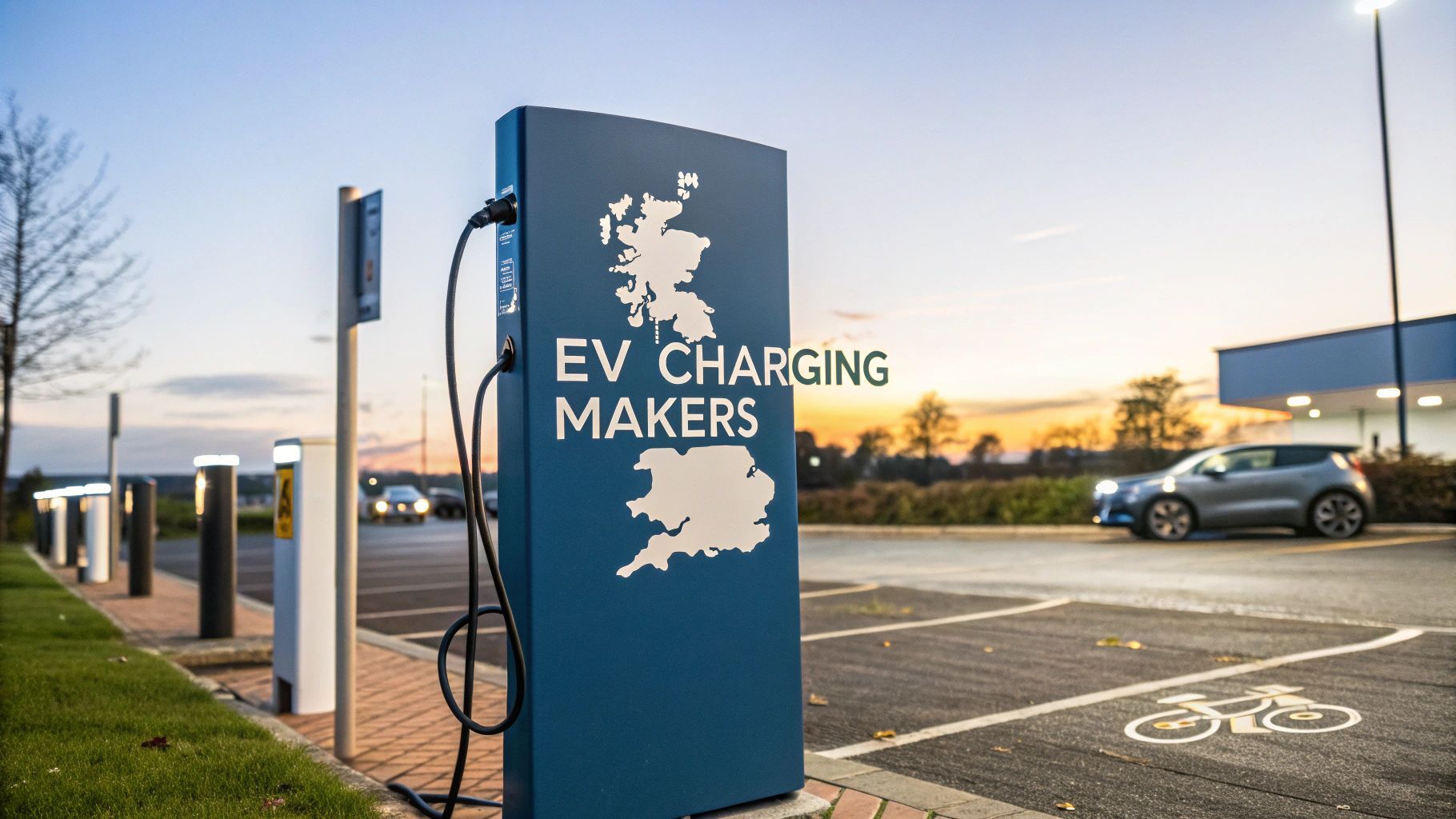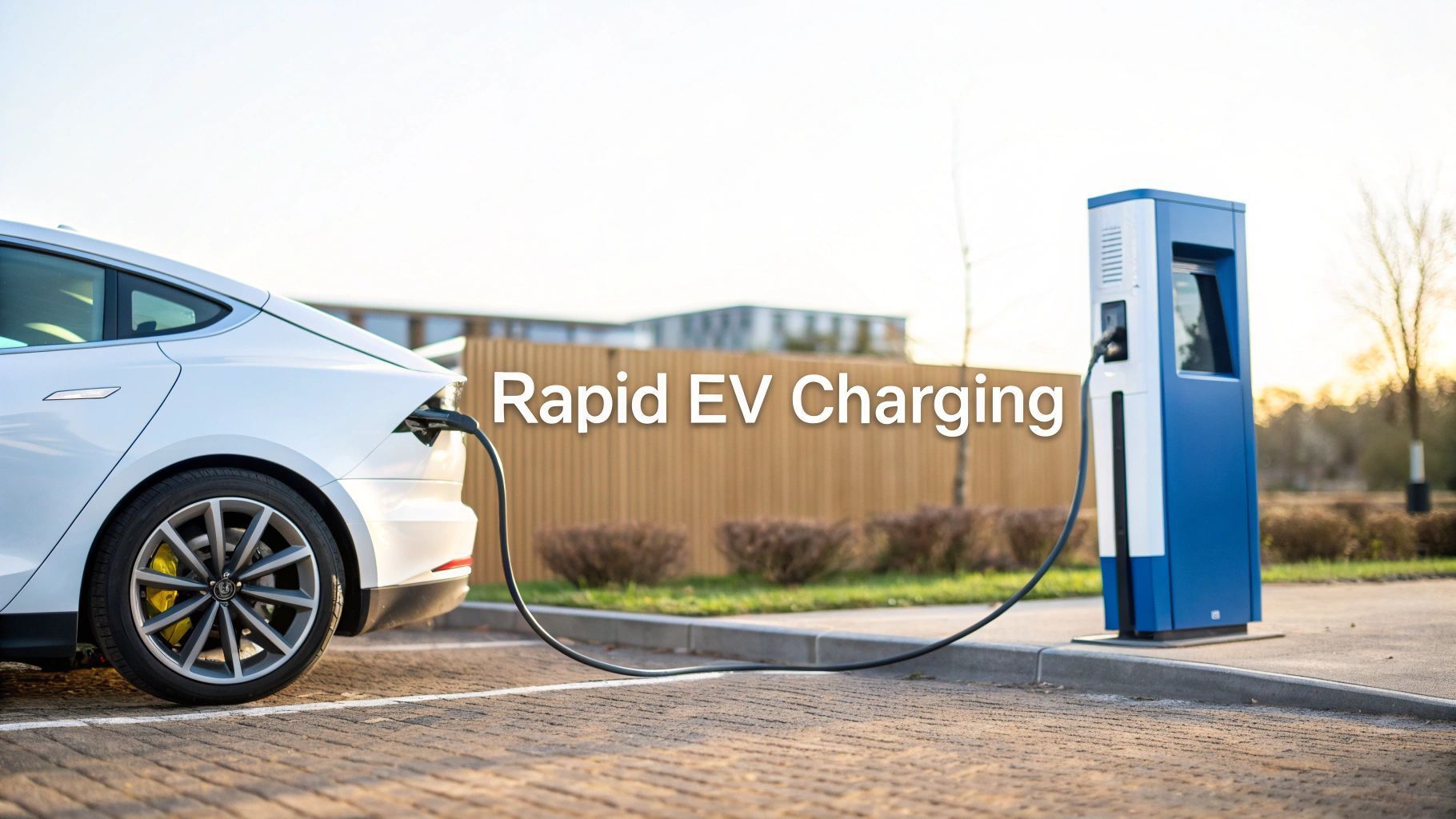Your Guide to Fast Charger Electric Vehicle Technology
When you hear about a fast EV charger, we’re talking about a serious step up from your standard home setup. These units can often pump in hundreds of miles of range in less than an hour, making long distance electric travel not just doable but genuinely practical. The secret lies in how they deliver power: by sending high voltage Direct Current (DC) straight to the battery, bypassing the car's much slower internal converter.
Unlocking the Speed Behind Fast EV Charging

So, what really separates a public fast charger from the one in your garage? It all comes down to the type of electricity being used and the sheer speed it can be delivered.
Think of it like filling a large water tank. Your home charger is like a garden hose—it’s reliable and gets the job done but the flow is limited. It takes its time. A rapid EV charger , on the other hand, is like a firefighter's hose, blasting a huge volume of power in a fraction of the time.
This isn't just about more power; it's about a smarter way of delivering it. A rapid charger supplies Direct Current (DC) power, which is exactly what your EV's battery needs. Your home provides Alternating Current (AC), which your car first has to convert into DC using its onboard charger unless you have a Rapid EV Charger. That conversion process is the bottleneck that keeps home charging speeds in the slow lane.
The AC versus DC Difference
The national grid delivers AC power to our homes and businesses. It’s perfect for running your telly or toaster but an EV battery can only store DC power. When you plug in at home, your car’s onboard charger has to do the hard work of converting AC to DC. To save on weight and space, these onboard converters(inverter) are pretty limited in how much power they can handle with most cars limited to 7 or 11 kWh.
Public Rapid (Level 3 in the USA) chargers flip this on its head. They house a massive, powerful converter right inside the charging unit on the street. This external unit does all the heavy lifting, changing AC from the grid into high voltage DC before the power even touches your car. By completely bypassing your vehicle's smaller, slower converter, the system can push electricity into the battery at an incredible rate. That's the magic behind rapid charging.
A rapid charger essentially takes the slow conversion process out of the car and puts it into a powerful, ground based unit. This allows for charging speeds that are anywhere from 10 to 50 times faster than a typical home setup.
Before we move on, let's put these speeds into perspective. The differences between charger types are significant, so here’s a quick breakdown to see how they stack up in the real world.
EV Charger Speeds at a Glance
| Charger Type |
Power Output (kW) |
Current Type |
Time to Add 100 Miles |
|---|---|---|---|
| Level 1 (AC) |
1-3 kW |
AC |
20+ hours |
| Level 2 (AC) |
7-22 kW |
AC |
4-8 hours |
| Level 3 (DC Rapid) |
50-150 kW |
DC |
20-40 minutes |
| Ultra-Rapid (DC) |
150-350+ kW |
DC |
10-20 minutes |
As you can see, jumping from a standard home AC charger to a public DC fast charger completely changes the game. It’s the difference between an overnight charge and a quick coffee break.
The Real World Benefit of Speed
This technological leap is what makes modern EV ownership so practical. The ability to top up quickly on a long journey completely transforms the driving experience, all but eliminating the 'range anxiety' that used to be a major concern for drivers.
Instead of waiting hours for a meaningful boost, you can often get enough range for the next leg of your journey in the time it takes to grab a sandwich.
This convenience is a game changer for:
-
Long distance travel : Making cross country trips in an EV a seamless reality.
-
Drivers without home charging : Providing a viable way for people in flats or rented accommodation to own an EV.
-
Fleet operations : Getting commercial vehicles back on the road in minutes, not hours, which is crucial for minimising downtime.
Ultimately, the development of a robust fast charger network is what’s making the switch to electric a genuinely practical choice for almost everyone.
Decoding Rapid and Ultra-Rapid Chargers
If you're out and about in your EV, you'll quickly realise not all public chargers are created equal. In the UK, the charging world is broken down into three main speeds: Fast, Rapid and Ultra-Rapid. Each one is designed for a different scenario, delivering vastly different amounts of power. Getting your head around these classes is the key to planning a smooth, efficient journey.
A fast charger will typically give you between 7kW and 22kW of power. You’ll often find these at places you plan to be for a few hours anyway—think supermarkets, public car parks and workplaces. They're perfect for adding a decent top up to your battery while you get on with your day if you have a few hours to wait, but dont work if your popping into Lidl for 10 mins as you'll probably get less than you used getting there.
Then we have the Rapid chargers. These are the real workhorses of the UK's public charging network, dotted along motorway service stations and major A-roads. Delivering power from 50kW right up to 400kW , this is where you start to see a serious drop in charging times, making long distance travel completely hassle free. A good rapid charger can often add around 100 miles of range in just over 30 minutes, depending on your car.
The Rise of Ultra-Rapid Charging
Sitting at the top of the pile is Ultra-Rapid charging. These formidable units start at 150kW and can push well beyond 300kW, representing the pinnacle of today’s charging technology. They are built for one thing: getting you back on the road as quickly as humanly possible. If your EV is compatible, an ultra-rapid session can add a huge amount of range in the time it takes you to grab a coffee.
This infographic really highlights the real world difference between the charger speeds.

As you can see, the jump to rapid and ultra-rapid power drastically cuts down your waiting time, making long journeys in an EV more practical than ever before.
Matching Charger Speed to Your Needs
So, which charger should you choose? It all comes down to your situation. There’s no point hunting down an ultra-rapid unit if you’re just topping up during your weekly shop; a standard fast charger will do the job perfectly and will often be cheaper.
-
Fast Chargers (7-22kW): Best for " at home" or "destination charging" at places like shopping centres, gyms or your workplace, where your car will be parked for a few hours or more.
-
Rapid Chargers (50-149kW): Ideal for en route charging on longer journeys. They give you a quick, efficient boost to get you to your destination without long delays. Think comfort break length stops.
-
Ultra-Rapid Chargers (150kW+): The ultimate choice for minimising downtime on cross country trips. These are for drivers who need to get back on the move with maximum speed.
The UK's charging infrastructure is in the middle of a major shift. While slower chargers still make up a large portion of the network, the real story is the explosive growth of high powered units. This focus on speed is tackling range anxiety head on and future-proofing the network for the next generation of EVs.
The evolution of the public network in the UK really backs this up. While slow chargers (3-7kW) still dominate in sheer numbers, it’s the rapid and ultra-rapid categories that are seeing the most dramatic expansion. In fact, ultra-rapid chargers ( 150kW and above) have surged by an incredible 131% in a single year to 8,842 units. They're now the third most common charger type, showing a clear investment in high speed infrastructure. However, operators are struggling to fit them due to grid availabilty with ZPN Energy one of the few bright lights in delivering unltra rapid speeds on small connections.
This strategic deployment means drivers can increasingly travel the length of the country with confidence. You can learn more about how this technology is being rolled out in our guide to ultra-rapid EV charging. It's a clear signal that the future of public charging isn’t just about availability—it’s about delivering power as quickly as possible.
Choosing the Right Connector for Your EV
Pulling into a public charging station for the first time can feel a little daunting but understanding the different plugs is much simpler than it looks. Think of it like your phone – it has a specific charging port and so does your electric vehicle. Here in the UK and across Europe, the fast charging landscape has thankfully settled on two main connector types, meaning most modern cars can plug in without any drama.
There's nothing worse than arriving at a charger electric vehicle station with a low battery, only to find the plug doesn’t fit. The good news is the industry has largely standardised on a single format for new cars, making those compatibility headaches increasingly rare. Once you know what to look for, you'll have the confidence to pull up to any rapid charger and get connected.
This diagram shows the layout of the Combined Charging System (CCS) Combo 2 socket, which is now the go to standard for DC fast charging in the UK and Europe.

You can clearly see how the design cleverly integrates two parts: the top section handles slower AC charging, while the two chunky pins at the bottom are reserved for high power DC fast charging.
The Main UK Fast Charging Connectors
For any driver using the UK's rapid and ultra-rapid network, there are really only two connectors you need to recognise: CCS and CHAdeMO . While one has become the clear winner for new vehicles, the other still supports thousands of popular EVs on our roads today.
-
CCS (Combined Charging System): This is the undisputed champion in the UK and Europe. It smartly combines a standard AC charging plug with two large DC pins directly below it, all in one neat unit. Almost every new EV sold today—from manufacturers like Volkswagen, Audi, BMW, Hyundai and Kia—uses the CCS standard.
-
CHAdeMO: An early pioneer in DC fast charging, this connector is still found on some very popular Japanese models, like the Nissan LEAF and Mitsubishi Outlander PHEV. The plug itself is large and round but its presence is fading as nearly all manufacturers have now switched to CCS .
The widespread adoption of CCS means that if you buy a new electric vehicle in the UK today, it will almost certainly be compatible with the vast majority of rapid and ultra-rapid chargers across the country.
What About Tesla?
Tesla has famously used its own connector in North America for years. However, to fall in line with regional standards, all new Tesla models sold in the UK and Europe now come factory fitted with a standard CCS port. This is fantastic news for drivers, as it opens up the entire public fast charging network, not just Tesla's own Superchargers.
For older Tesla models with the original proprietary port, adaptors are readily available that allow them to use CCS chargers. This flexibility ensures all Tesla drivers can make the most of the ever expanding public infrastructure.
Ensuring a Perfect Match Every Time
Worrying about compatibility is fast becoming a thing of the past. Modern tools make it incredibly simple to find the right charger for your car, wherever you are.
-
Use Charging Apps: Apps like Zap-Map or Bonnet are brilliant for this. You can filter charging stations by connector type, so if you select CCS or CHAdeMO , the map will only show you locations you can actually use.
-
Check Your Car's Navigation: Most modern EVs have built in navigation that does the hard work for you. When you need to top up on a long journey, it will automatically route you to compatible charging stations.
By taking a moment to identify which connector your car has, you can eliminate any guesswork. This simple piece of knowledge turns public fast charging from a potential worry into a seamless part of your EV ownership experience.
The UK Rapid Charging Network Is Growing
One of the biggest worries for anyone thinking about switching to an electric vehicle is the fear of running out of power on a long journey. But the reality on the ground is changing, and fast. The UK's public charging infrastructure isn't just growing; it's expanding with a clear strategy, focusing on high speed, reliable options that make long distance travel a total non issue.
This rapid development means finding a rapid charger for an electric vehicle is getting easier by the day. What was once a scattered collection of individual units is quickly maturing into a robust, dependable network designed to support the ever increasing number of EVs on British roads.
Strategic Placement Along Key Routes
A huge part of this growth story isn't just about the number of chargers, but where they're being installed. Major efforts have focused on creating charging hubs along the UK's vital transport arteries—motorways and major A-roads. This smart placement is the key to enabling seamless cross country travel.
These hubs often feature multiple rapid and ultra-rapid chargers, which cuts down on queues and ensures a spot is free when you need it. They're turning service stations from simple petrol stops into modern energy destinations where drivers can get a substantial battery top up in the time it takes to grab a coffee and stretch their legs.
The result? A network that intelligently supports how people actually drive. You no longer have to meticulously plan your route around the handful of available chargers; you can travel with the confidence that high speed options will be there when you need them.
A Data Driven Look at Expansion
The numbers behind the UK's network growth are genuinely impressive and paint a clear picture of progress. The focus has decisively shifted towards higher powered units that deliver the speed today's EV drivers expect. This deliberate move is quickly making range anxiety a thing of the past.
In a recent six month period alone, the UK's EV charging infrastructure saw a huge expansion, especially in ultra-rapid chargers capable of delivering 150 kW or more. A massive 1,598 new ultra-rapid chargers were installed, marking a 23% increase and bringing the total to over 8,600 units. For the first time, ultra-rapid chargers now outnumber rapid chargers on the public network.
This rapid deployment of high speed infrastructure is the single most important factor in reassuring drivers about the practicality of long distance EV travel. The numbers prove that the network is not only keeping pace with EV adoption but is actively preparing for the future.
This commitment to building a future proof network is also being supported by innovations in energy management. To see how this works in practice, discover how our battery storage systems are powering the UK's EV revolution by providing stable, reliable power to these new charging hubs.
Addressing Regional Distribution
While major routes are a priority, there's also a serious effort to improve charger distribution across all regions of the UK. Historically, chargers were concentrated in London and the South East but investment is now flowing into other areas to close that gap.
-
Growing Density: Scotland and the North of England are seeing significant increases in rapid charger installations, creating better connectivity for local residents and tourists.
-
Local Authority Schemes: Many local councils are proactively installing on street and destination chargers, making EV ownership more practical for people without off street parking.
-
Private Investment: Supermarkets, retail parks and hotels are increasingly installing their own fast chargers, creating a more diverse and accessible network away from the motorways.
This balanced approach ensures that as the number of EVs grows, the infrastructure is there to support them, no matter where they are in the country. The constant improvement in charger availability is tangible proof that the UK is fully committed to an electric future.
How to Use a Fast Charger Effectively

Knowing how a fast charger works is one thing but using the network efficiently is a completely different ball game. Pulling up to a public charging station should be simple and stress free. With a few practical tips, you can save time, money and make sure every charging session is as smooth as possible.
From common courtesy at busy stations to the different ways you might pay, this guidance will help you navigate the public network like a seasoned pro. The UK's public EV charging capacity has now hit major milestones, with over 80,998 public charging devices available across 39,773 distinct sites. This infrastructure supports a total of 115,241 connectors and reflects a 30% surge in charger numbers over the previous year. You can discover more insights about the UK's expanding EV market and its supporting infrastructure to see how this rapid growth is making electric travel easier than ever.
Understanding the Charging Curve
One of the most important concepts for any EV driver to get their head around is the 'charging curve'. This explains why your vehicle's charging speed isn't constant throughout a session.
Think of it like pouring water into a glass. At first, you can pour quickly but as the glass fills, you have to slow down to avoid spilling. An EV battery behaves in a very similar way.
A fast charger will deliver its peak power when the battery is at a low state of charge, typically between 20% and 50% . As the battery fills up, particularly beyond 80% , the vehicle's battery management system (BMS) dramatically slows the charging speed to protect the battery cells from damage.
This means the final 20% of a charge can often take as long as the first 80% . For efficient travel, it's almost always faster to stop twice for shorter periods—charging to 80% —than to wait for a single charge to reach 100% .
Maximising Your Charging Speed
Several factors can influence how quickly your battery charges, even at the most powerful ultra-rapid station. By understanding these variables, you can take steps to ensure you're getting the best possible performance out of every stop.
-
Arrive with a Warm Battery: A cold battery charges much more slowly. If you've been driving for at least 20-30 minutes, your battery will be at an optimal temperature to accept a fast charge. Some modern EVs even have a preconditioning feature that automatically warms the battery as you navigate to a known fast charger.
-
Know Your Car's Limit: Not all EVs can accept the maximum power a charger can deliver. If your car has a maximum charge rate of 100 kW , plugging into a 350 kW ultra-rapid charger won't make it charge any faster. Check your vehicle's specifications to manage your expectations.
-
Aim for the 80% Sweet Spot: As we mentioned, charging speed drops off a cliff after 80% . Unless you absolutely need the full range to reach your next destination, unplugging at 80% is the most time efficient strategy for long journeys.
Charging Etiquette and Payment Methods
As the EV community grows, a few simple rules of etiquette help make public charging a smoother experience for everyone. Always move your vehicle as soon as it has finished charging to free up the bay for the next driver. At busy hubs, avoid occupying a space longer than necessary, especially if others are waiting.
Starting a charge is also straightforward, with most networks offering a range of payment options.
-
Contactless Payment: Many new chargers now include contactless card readers, making payment as simple as buying a coffee.
-
Network Apps: Most major charging networks have dedicated smartphone apps. You link your payment details once, then use the app to locate chargers and start or stop your session.
-
RFID Cards: Some networks still provide members with an RFID card, which you simply tap on the charger to begin.
By following this advice, you can make sure every interaction with a fast charger is quick, efficient and hassle free.
What Comes Next for Rapid Charging
The world of charging is moving at an incredible pace. What seems futuristic today will soon become the standard, as the push for faster, more convenient power reshapes not just the charging experience but the entire infrastructure supporting our electric future.
The next generation of fast charger technology promises to make refuelling an EV as quick and simple as a traditional stop at the petrol station. This forward momentum isn't just about passenger cars, either—huge advancements are being made for heavy duty vehicles, too.
Pushing the Boundaries of Power
Perhaps the most exciting development on the horizon is the Megawatt Charging System (MCS) . This is a genuine game changer for electric lorries and buses, designed to deliver enormous amounts of power in a very short time. Imagine a charger capable of replenishing a heavy goods vehicle's massive battery during a driver's mandatory 45 minute break. That’s the reality MCS is creating.
For passenger cars, the race continues to push well beyond the current 350 kW ultra-rapid standard. We can expect to see chargers capable of even higher outputs becoming more common, making a 10 minute charge for 200 miles of range a real possibility for the next wave of EVs.
The integration of smart technology is set to make charging more than just a power up. It will become an intelligent, two way exchange between the vehicle and the grid, helping to balance energy supply and demand.
Smarter and More Integrated Charging
The future isn't just about raw speed; it's about intelligence. Vehicle-to-Grid (V2G) technology is a key part of this evolution, allowing EVs to not only draw power from the grid but also feed it back during times of high demand. This clever approach turns a parked EV into a mobile energy storage unit, helping to stabilise the grid and even earn the owner money.
This is where battery storage really comes into its own. By storing cheap, off peak energy, battery systems can release it to power chargers during peak times, reducing strain on the grid and lowering costs for everyone. You can learn more about how battery backed EV charging helps manage these energy flows efficiently.
Finally, the charging hub itself is evolving. We're already seeing a shift away from single, lonely charger bays towards full service destinations. These future hubs will offer amenities like cafes, shops and lounges, transforming the act of charging from a chore into a pleasant and productive break. The focus is on creating a seamless customer experience that makes topping up your EV more convenient than ever before.
Frequently Asked Questions
Jumping into the world of fast charging can bring up a few questions, especially if you're new to driving an EV. To help you use the public network with complete confidence, we’ve put together clear, straightforward answers to some of the most common queries.
A bit of knowledge goes a long way. Understanding the finer points of battery health, charging costs and best practices will make every stop smoother and help you get the most out of your vehicle.
Will Charging Damage My EV Battery?
This is a really common concern but the good news is that modern EVs are built with sophisticated Battery Management Systems (BMS) to protect them. The BMS is always monitoring the battery's temperature and voltage, automatically slowing down the charging rate as it fills up—especially after it hits 80% .
That said, relying on DC fast charging all the time can lead to slightly faster battery degradation over the long run compared to slower AC charging. Research has shown that EVs in hotter climates that are frequently fast charged see a more noticeable drop in battery health over time.
For everyday top ups, Level 2 AC charging is gentler on your battery. It's best to think of DC fast charging as a tool for long journeys or when you're genuinely pushed for time. This approach will help minimise long term battery wear.
How Much Does It Cost to Use a Fast Charger?
The cost of a public fast charge can vary quite a bit, depending on the network provider, the location and even the time of day. Pricing usually works in one of two ways.
-
Per Kilowatt-hour (kWh): This is the most common method, where you pay for the exact amount of energy transferred to your car. Think of it like paying for petrol by the litre.
-
Per Minute: Some providers charge for the time your vehicle is physically connected to the charger, no matter how much energy is delivered.
As a general rule, you can expect to pay a premium for the convenience of ultra-rapid speeds. It's always a good idea to check the pricing on the network's app or the charger screen before you plug in.
How Long Does an EV Battery Last?
EV batteries are designed to be incredibly durable. On average, a modern EV battery degrades at a rate of just 1.8% per year, which means it should easily outlast the typical lifespan of the vehicle itself. At that rate, an EV battery could last 15-20 years or more while still holding onto most of its original capacity.
Of course, a few things can influence this, like the battery's cooling system, your personal charging habits and the climate you live in. Sticking to best practices—like keeping the charge between 20% and 80% for daily use and limiting exposure to extreme heat—will help you get the most out of it for years to come.
At ZPN Energy , we provide advanced energy management and rapid charging solutions to future proof your business. Explore our fully integrated systems today. https://www.zpnenergy.com








